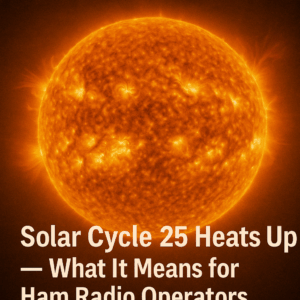
April 2025 | Joplin Amateur Radio Club (W0IN)
If you’ve noticed better-than-usual conditions on the HF bands lately, you’re not imagining things. Solar Cycle 25 is delivering some of the most exciting propagation opportunities we’ve seen in years, and it’s just getting started.
📈 Solar Activity on the Rise
The Sun is nearing its peak activity for Solar Cycle 25, expected sometime in 2025 or early 2026. Sunspot numbers have surged, and with them come stronger F-layer ionization — which means better long-distance HF communication, especially on the higher bands like 10, 12, and 15 meters.
In recent months, even modest stations with dipoles and 100 watts have been making solid DX contacts into Europe, Asia, and South America on 10 meters during daytime hours — a band that was almost silent just a few years ago. This is a golden opportunity for hams of all license levels to explore the world of HF DX.
🌍 What Bands Are Hot?
-
10 meters is wide open during daylight hours. Short skip, long haul, and even sporadic E are all showing up.
-
12 and 15 meters are performing well, especially in late morning and early afternoon.
-
17 and 20 meters continue to be reliable daytime bands.
-
80 and 40 meters are still best for nighttime operation, but enhanced MUF (Maximum Usable Frequency) is improving their performance too.
Keep an eye on propagation tools like VOACAP, solar indices (SFI, A-index, K-index), and sites like hamqsl.com to track real-time conditions.
⚡ Watch for Geomagnetic Storms
With increased solar activity comes a flip side: the occasional solar flare or coronal mass ejection (CME) can spark geomagnetic storms, temporarily disrupting HF communications — especially polar paths and low bands. But don’t pack it in when a storm hits — VHF operators can sometimes catch auroral propagation on 6 and 2 meters during these events.
🛰️ Don’t Forget the Satellites
High solar activity doesn’t just impact HF — it can also alter conditions for satellite operators. Satellites in low Earth orbit may experience drag changes due to atmospheric heating. If you enjoy working birds like SO-50 or RS-44, now’s a great time to check your tracking software for updated TLE data and enjoy stable passes.
🔧 Time to Tune Up Your Station
With the bands wide open, this is the time to:
-
Revisit your antenna setup — even a basic wire dipole can do wonders at the current solar peak.
-
Try new digital modes like FT8, JS8Call, or RTTY.
-
Log your contacts and chase DXCC, Worked All States, or special event stations.
-
Encourage Technician-class hams to upgrade — conditions are ripe for exploring more bands!
📡 Join the Joplin Club On the Air
Let’s make the most of these fantastic conditions together. W0IN members are encouraged to hop on the HF bands and check into nets, call CQ, or try for a new country. If you need help getting on HF, reach out — we’ve got Elmers ready to lend a hand.
2025 is shaping up to be an unforgettable year for HF radio. Don’t miss it — turn on your rig, spin the dial, and let the ionosphere carry your signal around the globe.
See you on the bands!